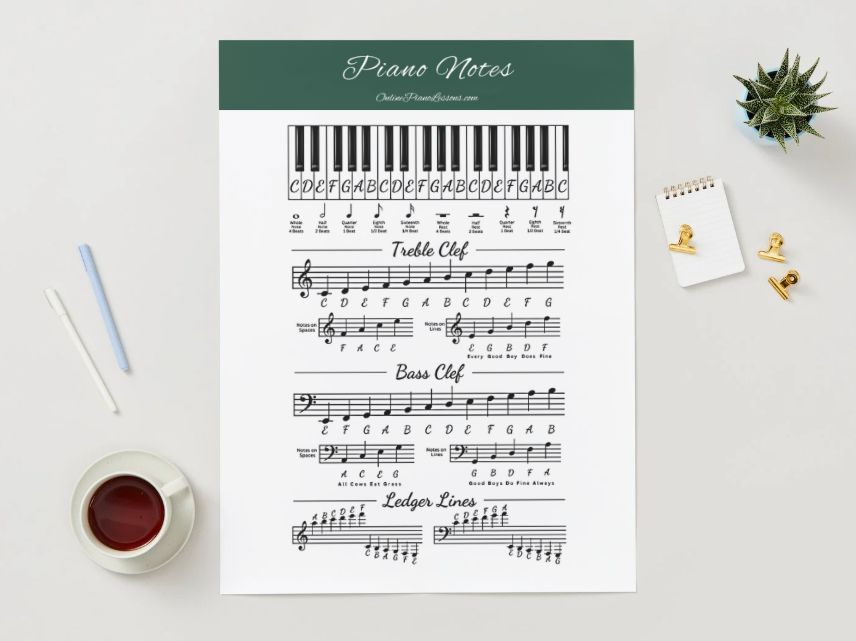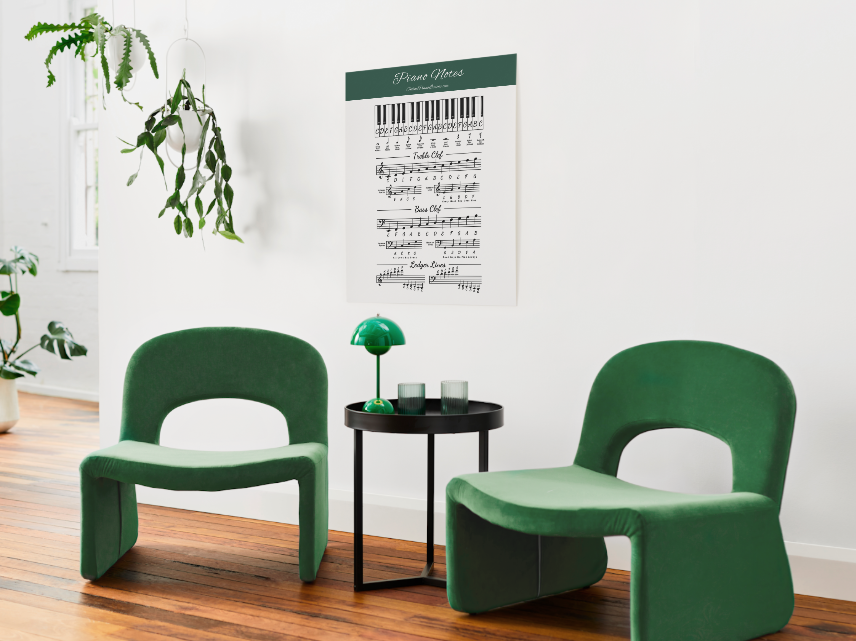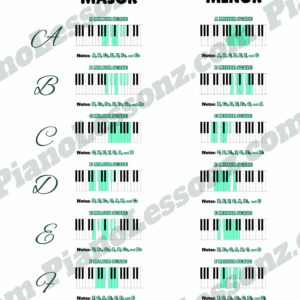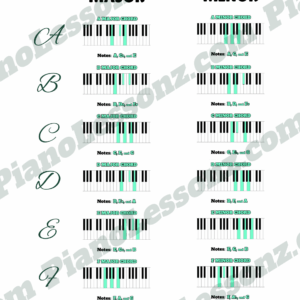Piano Notes Chart
Original price was: $4.99.$2.99Current price is: $2.99.
🏡 Please Support Local Businesses!

This item was created with care by Thomas Hlubin, Pianist Composer, Piano Teacher, & Founder of OnlinePianoLessons.com.
Beautifully designed Piano Notes Chart for quick and easy reference while playing and learning your favorite piano songs. Download instantly after purchase. It also looks great printed out or framed as decoration near your piano! Scroll down for full product description.



Product: Piano Notes Chart
File Type: PDF (zip file containing 18 PDF files, each with a different size)
PDF Dimensions: 4″x5″, 4″x6″, 5″x7″, 6″x8″, 6″x9″, 8″x10″, 8″x12″, 8’5″x11″, 9″x12″, 10″x15″, 12″x16″, 12″x18″, 16″x20″, 16″x24″, 18″x24″, 20″x30″, 24″x36″, and 32″x40″
⚠️ PLEASE NOTE: This is a DIGITAL PRODUCT. Upon purchase, all files can be downloaded instantly—NO physical items will be shipped to your address.
Have a question about this item or having trouble downloading it? Please email me at info@onlinepianolessons.com and I’ll get back to you asap with a quick solution.

Thomas Hlubin
Founder & Owner of OnlinePianoLessons.com
My YouTube Channel | My TikTok Channel
![]()
Benefits of Using a Piano Notes Chart
Learning to play the piano can feel overwhelming at first, especially when you’re trying to memorize the location of each note, interpret sheet music, and develop muscle memory all at once. That’s where a Piano Notes Chart becomes a valuable tool for beginners and even intermediate players. More than just a reference sheet, a Piano Notes Chart can become an essential learning aid that streamlines your music education, supports creativity, and enhances your ability to read and understand music faster.
A Piano Notes Chart serves multiple functions. It helps bridge the gap between the visual layout of the piano keys and the abstract world of musical notation. With regular use, it becomes a reliable guide that reinforces note recognition and placement—on both the instrument and the grand staff. Let’s explore the many benefits this simple yet powerful tool offers and why you should consider keeping one within reach of your keyboard or piano.
Instantly Connect Piano Keys to Note Names
One of the biggest challenges for beginners is memorizing which letter name corresponds to each piano key. While the layout of the keyboard follows a repeating pattern of white and black keys, many learners find it difficult to remember which note is which without a visual aid.
A Piano Notes Chart shows the entire keyboard layout and labels each key with its corresponding letter (A through G). It typically includes the sharps and flats, too, making it easy to understand how the chromatic scale works in both directions. When placed above or near your piano, the chart becomes a constant visual cue. You can glance at it while practicing and quickly reinforce your knowledge of each key’s letter name.
This is especially helpful when learning new songs, sight-reading, or composing music. Instead of stopping to guess a note or count keys, you simply refer to the chart and keep playing with confidence.
Easily Learn the Grand Staff Layout
The grand staff—comprised of the treble and bass clefs—is the foundation of written music for the piano. For beginners, it can be difficult to remember which lines and spaces correspond to which notes. This is where the Piano Notes Chart proves incredibly useful.
A quality Piano Notes Chart usually includes a diagram of the grand staff, clearly showing how each note on the staff lines and spaces corresponds to a specific piano key. This side-by-side visual mapping reinforces both your spatial memory and your understanding of music notation.
With regular practice, your brain begins to link the position of a note on the staff to the physical key on the piano. Instead of guessing whether a note on the second line of the treble clef is a G or a B, you’ll recall the chart and remember with ease. This leads to faster reading skills and more fluid performances over time.
Clarify the Definitions of Common Musical Notes
Understanding musical symbols is essential to reading and playing music. A comprehensive Piano Notes Chart doesn’t just stop at naming keys—it often includes visual representations and definitions of common note types and other notation symbols.
For example, it might show:
-
Whole notes, half notes, quarter notes, and eighth notes
-
Corresponding rests
-
Time signatures
-
Clef symbols (treble, bass)
-
Dynamic markings like forte (f), piano (p), and more
Having these elements on the chart gives you a quick-reference guide to musical theory basics. You won’t have to flip through books or search online every time you forget what a dotted half note means. This makes the chart not only a practice aid but a compact educational resource you can rely on.
Enhance Musical Creativity and Confidence
Whether you’re composing a melody, improvising chords, or just experimenting with sounds, the Piano Notes Chart can serve as a creative launchpad. Knowing where notes are and how they relate to the staff allows you to try new ideas with more freedom.
As you internalize the note positions, you’ll spend less time second-guessing and more time making music. This increase in confidence naturally fuels creativity. Instead of worrying about whether you’re playing the right note, you’ll focus more on expression, timing, and musical storytelling.
This can be especially beneficial for students who want to write their own songs or explore genres like jazz, pop, or classical composition. When your note-reading and key recognition become second nature, the creative process feels more fluid and enjoyable.
Aesthetic Value for Your Music Space
In addition to being practical, a well-designed Piano Notes Chart can be a beautiful addition to your piano room or music studio. Many charts are available in artistic styles, printed on high-quality paper or canvas, and designed to look great when framed and displayed near your instrument.
Whether you choose a vintage-style layout, a colorful modern design, or a sleek minimalist version, your chart can add visual charm to your practice environment. It becomes part of your musical atmosphere, reminding you of your dedication and love for music every time you sit down to play.
Framing and hanging your Piano Notes Chart next to your keyboard or piano also makes it more likely that you’ll refer to it often. Rather than being tucked away in a drawer or music binder, it stays front and center—always ready to offer guidance or inspiration when you need it most.
A Piano Notes Chart is more than a beginner’s cheat sheet—it’s a powerful, multi-functional resource for learning, practicing, and enjoying music at a deeper level. It simplifies note recognition, supports grand staff literacy, explains essential notation, and boosts your confidence as a musician. And as a bonus, it can be a stylish addition to your musical environment.
Whether you’re just starting your piano journey or looking to refresh your knowledge, investing in a Piano Notes Chart is a smart move. It’s an easy, effective way to enhance your learning and keep your musical skills sharp. Keep it close, refer to it often, and watch how quickly your understanding of the piano begins to grow.
Only logged in customers who have purchased this product may leave a review.




Reviews
There are no reviews yet.